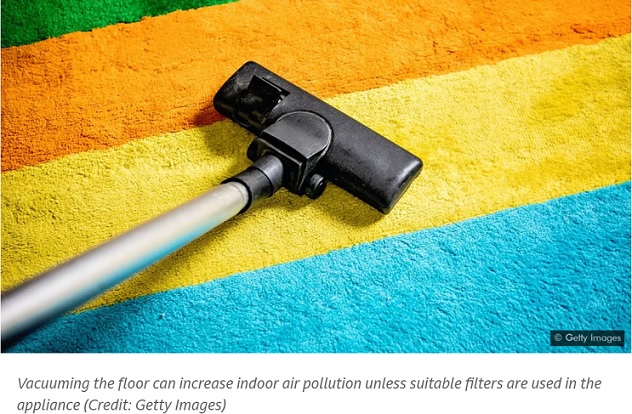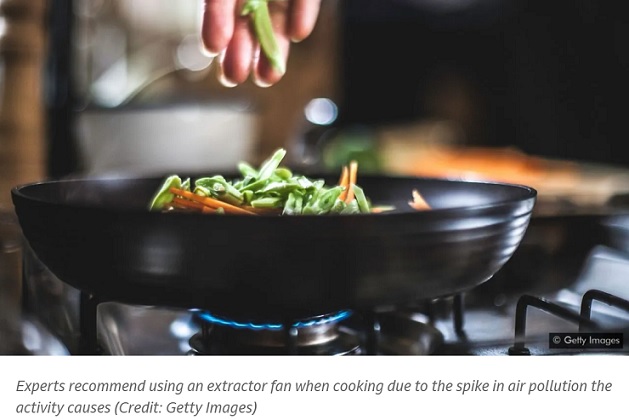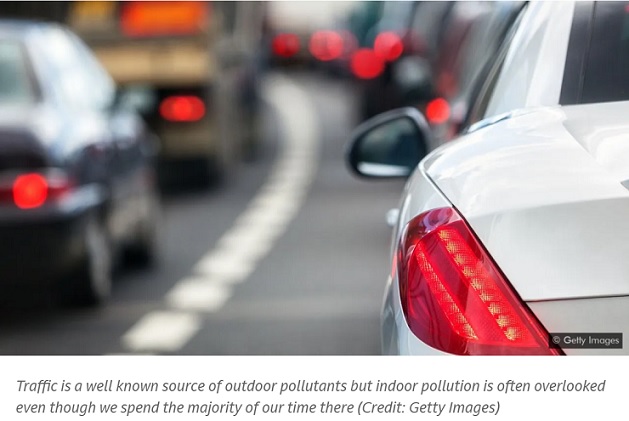
Experts say most of our exposure to air pollution could occur indoors. What are the most effective ways to reduce indoor pollutants?
When the Covid-19 pandemic forced global lockdowns earlier this year, one positive – if temporary – upside was a reduction in outdoor air pollution. From the US to China, pollution levels dropped significantly. As countries have opened back up, however, pollution levels have rebounded to pre-pandemic levels.
But this focus on outdoor air pollution overlooks a simple fact – most of our exposure to air pollution actually happens indoors. According to the Environmental Protection Agency (EPA), the levels of indoor air pollutants can be two to five times higher than outdoors – and lockdowns exacerbated that even further.
Between early March and early May 2020, Airthings, a Norway-based manufacturer of smart air-quality monitors, analysed data of their users in the US and Europe and found levels of carbon dioxide and airborne particles called volatile organic compounds (VOCs) increased by 15 to 30% in more than 1,000 homes across several European countries. Similarly, data collected by Dyson of its registered air purifiers in 11 cities over four continents, found levels of VOCs and nitrogen dioxide (NO2) had risen in people’s homes since lockdown.
"We spend 90% of our time indoors in developed countries, and yet all the focus, when it comes to pollution, is on the 10% of our time that we spend outdoors," says Nicola Carslaw, a professor of indoor air chemistry at the University of York. "But the vast majority of people’s exposure to pollution happens indoors."
Of course, it’s also worth noting that it isn’t either-or: outdoor air pollution comes inside, too. And some of the most lethal types of pollution, including nitrogen oxides and nanoparticles, are also the tiniest particles – minuscule enough that they can sail through not only the walls of the lungs and into the bloodstream, but around closed doors and into homes.
According to the World Health Organization (WHO), around 3.8 million people a year die from the exposure to household air pollution. Poor indoor air quality has been linked to a range of illnesses, including asthma, pneumonia, lung cancer, chronic obstructive pulmonary disease and cardiovascular disease.
Indoor air pollution comes from a huge range of activities. Fine particles are released from activities like cooking (frying and roasting in particular), cleaning, and from fires and candles. Around the world, three billion people are estimated to still cook with open fires or simple stoves fuelled with kerosene, coal or biomass, which produce large amounts of indoor pollution. But even using modern stoves can pose a risk.
You are more exposed to PM2.5 (tiny particles that are hazardous to human health when inhaled) cooking an omelette in your kitchen than standing on an average London roadside, one study has found. Another study found that cooking a Sunday roast or Thanksgiving dinner could produce higher levels of PM2.5s than are found on the streets of Delhi, one of the most polluted cities in the world. These particles posed a particular risk to the respiratory system, according to Marina Vance, an environmental engineer at the University of Colorado Boulder and her colleagues who conducted the study. Surprisingly the highest PM2.5 levels were detected when making breakfast.
This is why experts stress that people should always use the extractor fan or open a window when cooking. (Read more about the hidden risks of cooking your food).
We also use a lot of airborne chemicals in homes. They are embedded in the glues used in furniture as well as in paints, sealants and wood and building materials. There are also VOCs emitted from household cleaning products, personal care products like shower gels and fragrances, glues, inks and air fresheners. Individually, some VOCs are more harmful than others, although just about all react with oxides of nitrogen to create ground-level ozone.
"If you plug in an air freshener that’s constantly releasing VOCs, we know that they can react indoors to form particles," says Carslaw. "If you told people they are being exposed to particles outdoors from vehicles they would get quite annoyed and probably want to avoid certain roads – but they would then happily plug in an air freshener not realising that they are also generating particles." If you must use a scented cleaning product or air freshener, she says, do so in moderation and ventilate the room.
Vacuuming is also another source of indoor air pollution unless suitable high grade filters are used, and mopping with certain cleaning products can also increase the levels of airborne chemicals.
Other pollutants include mould spores and mould fragments resulting from damp and condensation. Combustion gases, including carbon monoxide, carbon dioxide and nitrogen oxides, are also primarily released from heating stoves and gas hobs, although candles, oil lamps and tobacco smoking also contribute these. Although gases like nitrogen dioxide also occur outside, they can accumulate at far higher concentrations indoors.

"Cooking and cleaning are two of the main sources of indoor pollution," says Carslaw. "When you cook, you generate nitrogen oxide and particles, which are the same pollutants that you find outdoors – just a different source."
Radon, a naturally occurring, odourless, radioactive gas can also enter a builds through the ground, or cracks in walls, and can accumulate indoors if there is inadequate ventilation. In the US, radon exposure is the leading cause of lung cancer among non-smokers.
A report last year by indoor air pollution experts Airtopia found that nearly half of UK homes have high indoor air pollution. Data from 47 homes in Birmingham, London and the Home Counties of England found a fifth of homes showed more than double the amount of safe levels of formaldehyde. And 45% of homes had significantly increased levels of VOCs – with 28% of householders in homes with high VOC readings reporting multiple respiratory difficulties.
A recent academic study conducted by researchers in Portugal assessed the air quality in homes where newborns and their mothers were living. They found that three quarters of the homes experienced PM2.5 levels in excess of limits recommended by the WHO while 41% of the homes exceeded the recommended limits for larger PM10 pollutants.
However, while indoor air pollution levels may occasionally get quite high and certain compounds can reach toxic levels, every house is different, and every person influences indoor air in different ways according to their activities and habits. That means that it varies considerably and can be even more difficult than outdoor air pollution to research.
"Outdoors we can all see what air pollution is doing day to day. Indoors, in our own homes, we just don’t know," says Alastair Lewis, science director at the UK’s National Centre for Atmospheric Science. "In poorly ventilated homes with significant sources, concentrations of particles can be much higher indoors than outdoors.
"In our own research, looking at VOCs in homes in the UK, there can be a factor of a 1,000 difference between two homes right next door to one another."
For reducing indoor air pollutants, experts agree that both source removal and ventilation are key.

"In most cases there are two obvious solutions to most of the sources of air pollution indoors," says Ben Barratt, a senior lecturer in environmental exposure and public health at Imperial College, London. "One is removing the source of pollution in the first place – so using an electric cooker rather than a gas cooker. Be cautious about using cleaning products and don’t overuse them; be cautious about using candles and incense and don’t overuse them. In all cases, if you realise you are creating air pollution indoors then ventilate, open a window."
But if you live near a busy road or in an urban centre, opening a window may only introduce more pollution indoors. In that case, experts recommend filtration via a Hepa (High Efficiency Particulate Air) filter, which can effectively remove particulates of 0.3 micrometres and larger. Still, a 0.3 micrometre particle is many times larger than nitrogen oxides or nanoparticles – so a Hepa filter isn’t a panacea.
One issue, however, is the reliability of the claims made by air purifier companies. "The thing that concerns me about these air cleaners is that they are largely unregulated,” says Carslaw. “So any company can just put one on the market and say this removes 99% of pollutants.”
To improve energy efficiency and reduce carbon emissions, many architects are moving towards more air-tight buildings. But in doing so, we should be careful not to compromise indoor air quality, say experts.

"We’ve got to be very aware that we don’t want to live in sealed boxes," says Barratt. "With more sealed and insulated buildings, we might not have to heat them so much and we might not suffer from outdoor air pollution so much – but we do need to be aware of things like humidity, mould spores, indoor air pollution, and ensuring good ventilation."
Already we spend 90% of our time indoors and as society shifts more towards working from home and generally spending more time indoors, the quality of our indoor air is more important than ever. There are often higher concentrations of pollutants inside our buildings than outside of them, but, alarmingly, indoor air remains largely unregulated. There clearly needs to be more public awareness about the link between indoor air quality and poor health.

